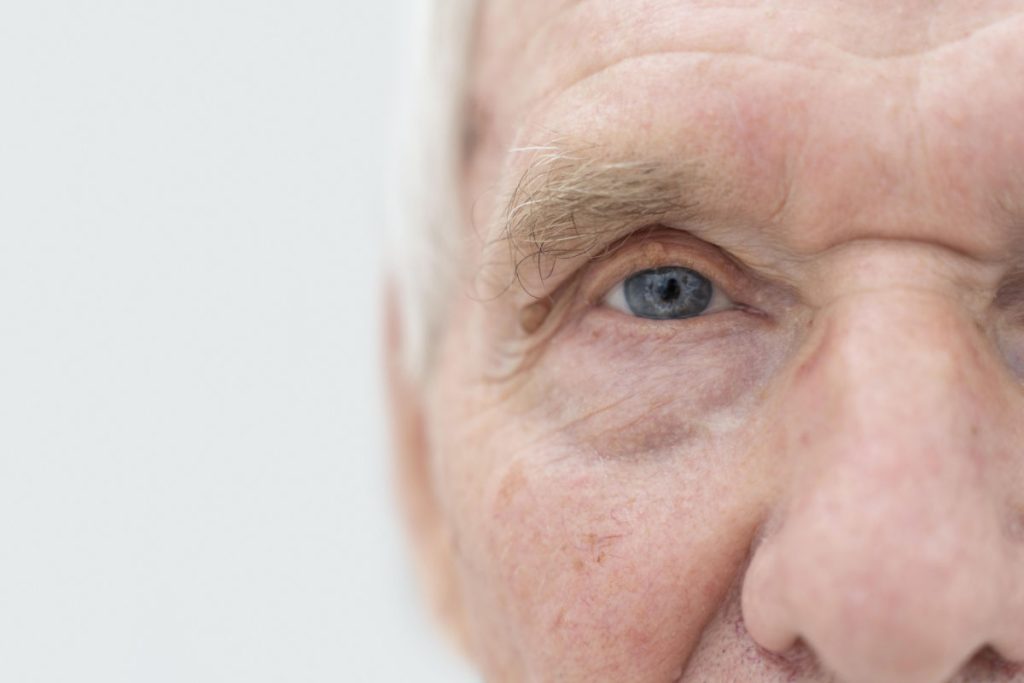
Surface-based laser refractive surgery uses laser to reshape the cornea so that light entering the eye can be focused uniformly onto the retina. If you have myopia (nearsightedness), your cornea is considered too steep and is therefore flattened with the excimer laser. The converse is true for hyperopia (farsightedness), where the excimer laser will steepen your cornea.
The main difference between surface laser refractive surgery procedures and LASIK is that no stromal flap is created. Instead, for the excimer laser to be able to reach the corneal stromal tissue that needs to be reshaped, the corneal epithelium (skin over the corneal surface) is either removed or lifted. With the corneal epithelium out of the way, the underlying corneal tissue can then be cut and remodeled by the excimer laser.
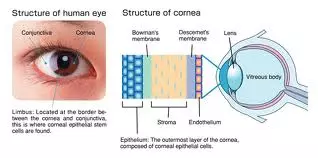
The cornea consists of 5 layers – the epithelium (outermost layer or ‘skin’ of the cornea), Bowman’s membrane, the stroma (thickest central layer of the cornea), Descemet’s membrane, and the endothelium (innermost layer of the cornea).
There are 3 main surface-based laser refractive surgery procedures. These are: PRK (photorefractive keratectomy), LASEK (laser assisted sub-epithelium keratomileusis) and Epi-LASIK (epithelial laser assisted in situ keratomileusis).
Photorefractive keratectomy (prk)
Photorefractive keratectomy (PRK) is a surface procedure where the corneal epithelium (skin covering the surface of the cornea) is removed, and the underlying corneal tissue is ablated with the excimer laser. No epithelial or stromal flap is created.
After laser, the cornea is protected with a bandage contact lens because the epithelium is unable to do so as it heals. With PRK, the removed corneal epithelium needs time to heal and regenerate, with the recovery time from PRK taking up to 72 hours. Recovery can therefore take longer than with LASIK. Also, as the epithelium contains many nerve endings, there will be considerably greater discomfort during the recovery period.
Just over a decade ago, PRK was the most commonly performed laser refractive surgery procedure in the world. Although it has since been superceded by LASIK, PRK has experienced a resurgence of late. This is partly due to the move towards reducing the risks associated with the creation of a corneal stromal flap.
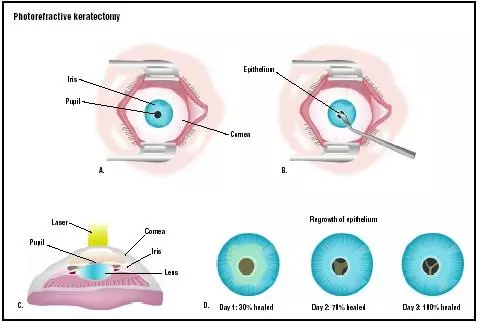
Steps involved in PRK: A) After topical anesthetic drops are instilled in the eye, a metal speculum is placed to keep your eyelids open. B) The corneal epithelium is removed with an instrument. C) After the epithelium is removed, the excimer laser remodels the corneal stroma to the desired shape. D) The corneal epithelium that has been removed with grow back over 3 days (Day 1: 30% healed; Day 2: 75% healed; Day 3: 100% healed).
Laser assisted sub-epithelium keratomileusis (lasek)
Laser assisted sub-epithelium keratomileusis (LASEK) is a surface procedure where the corneal epithelium (skin covering the surface of the cornea) is lifted, and the underlying corneal stromal tissue is ablated with the excimer laser. The corneal epithelium is then replaced following laser.
Unlike LASIK, no corneal stromal flap is created. And unlike PRK, LASEK does not involve removal of the corneal epithelium, and so a bandage contact lens is not required. Instead, the corneal epithelium is loosened with an alcohol solution and then lifted with a blade. Although the healing process may be quicker than PRK, it may involve similar levels of discomfort as PRK due to alcohol-related eye toxicity.
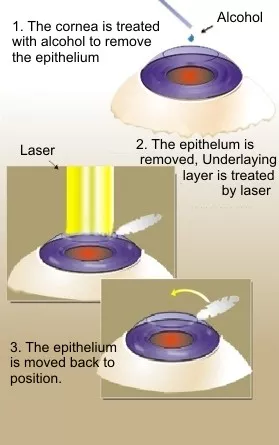
Epithelial-laser assisted in situ keratomileusis (epi-lasik)
Epithelial laser assisted in situ keratomileusis (Epi-LASIK) is also a surface procedure which is similar to LASEK, but instead of using alcohol, a blunt oscillating plastic blade (epithelial separator) is used to lift the corneal epithelium (skin covering the surface of the cornea). The underlying corneal tissue is then ablated with excimer laser. After laser remodeling, the corneal epithelium is placed back on the corneal surface.
The theoretical advantage of Epi-LASIK over PRK and LASEK is that there is no painful corneal epithelium removal, nor is there any potential alcohol-related toxicity to the eye. Therefore, patients having Epi-LASIK may have a quicker and more comfortable recovery process.
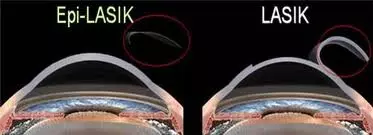
Epi-LASIK involves the lifting of a thinner epithelial flap, as opposed to the thicker stromal flap in LASIK. This theoretically maintains the benefits of LASIK (quicker and more comfortable healing) but minimizes associated LASIK risks (stromal flap-related complications).
The success rate of laser refractive surgery surface ablation procedures is 95% to 99% in many centers. Many patients achieve 20/20 or 6/6 vision without correction. Virtually everyone will achieve at least driving vision of 20/40 (6/12) unaided.
Although no corneal stromal flap is created, this does not mean that the procedure has no complications. So make sure you know what to expect and always listen to your surgeon regarding any instructions concerning eyedrops and caring for your eye after surgery.


